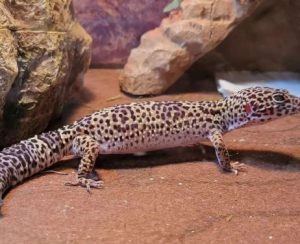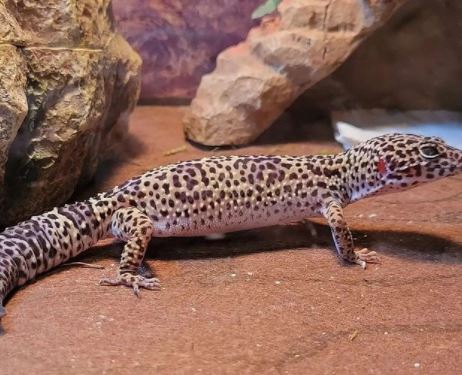Obese leopard gecko
Obese leopard gecko: Leopard geckos, with their distinctive patterns and docile nature, have become increasingly popular as pets among reptile enthusiasts. These fascinating creatures, native to the arid regions of Afghanistan, Pakistan, and parts of India, are small in size but offer countless hours of companionship and entertainment. With their unique ability to regenerate their tail and their nocturnal behavior, leopard geckos have captured the hearts of pet owners worldwide.
Brief Overview of Leopard Geckos as Pets
Leopard geckos (Eublepharis macularius) are known for their striking appearance characterized by a series of dark spots or “leopard-like” patterns covering their skin. They typically grow to be around 7 to 10 inches long and have a lifespan of 15 to 20 years if properly cared for.
These reptiles possess eyelids and are one of the few gecko species that have vocalizations, making them a delightfully interactive pet. One of the reasons leopard geckos make excellent pets is that they are relatively easy to care for.
Unlike other reptiles that require high humidity levels or live prey diets, leopard geckos thrive in a dry environment with moderate heat. They are insectivores by nature, feeding primarily on mealworms, crickets, and occasionally waxworms.
Introduction to the Topic of Obese Leopard Geckos
 While it is important for pet owners to provide their leopard geckos with proper nutrition and a suitable living environment, it is essential to address an alarming concern: obesity in these captivating creatures. Obesity can occur when leopard geckos consume excessive amounts of food or lack opportunities for physical exercise within their enclosures.
While it is important for pet owners to provide their leopard geckos with proper nutrition and a suitable living environment, it is essential to address an alarming concern: obesity in these captivating creatures. Obesity can occur when leopard geckos consume excessive amounts of food or lack opportunities for physical exercise within their enclosures.
Obese leopard geckos may appear cute or “chubby,” but this condition poses significant health risks. As responsible caretakers, it is our duty to understand the causes and consequences of obesity in leopard geckos and take necessary steps to prevent and treat this issue.
In the following sections, we will delve into the factors contributing to obesity in leopard geckos, how to identify an obese gecko, preventative measures owners can take, and effective strategies for managing weight loss. By being informed about this topic, we can ensure the well-being and longevity of our beloved leopard gecko companions.
Understanding Leopard Geckos
General Characteristics and Natural Habitat of Leopard Geckos
Leopard geckos (Eublepharis macularius) are a species of small reptiles that belong to the family Eublepharidae. They are native to the arid regions of Afghanistan, Pakistan, and parts of India. These geckos have distinct features that make them fascinating pets.
Their bodies are covered in scales with a characteristic leopard-like pattern, which gives them their name. Adult leopard geckos usually reach a length of 8 to 10 inches, with males being slightly larger than females.
In their natural habitat, leopard geckos thrive in rocky and desert environments where they can find shelter in crevices or underground burrows during the day. They are primarily nocturnal creatures, hunting at night when temperatures are cooler.
Due to their origins in arid regions, they have adapted to withstand dry conditions and can even store water within their bodies. This ability allows them to survive for extended periods without access to fresh water.
Diet and Feeding Habits of Leopard Geckos
Leopard geckos possess an insectivorous diet, meaning they primarily consume various types of insects. In captivity, it is crucial to provide a well-balanced diet that mimics their natural feeding habits. The primary food source for leopard geckos consists mainly of crickets, mealworms, waxworms, and roaches.
It is essential to ensure that the insects fed to leopard geckos are properly gut-loaded before being offered as food. Gut-loading involves feeding nutritious foods such as leafy greens or commercial insect diets to the prey insects before offering them as food for the gecko.
This process helps ensure that the leopard gecko receives optimal nutrition from its prey items. Additionally, it is vital to provide a calcium supplement for leopard geckos to prevent deficiencies and promote healthy bone development.
Dusting the prey insects with a calcium powder before feeding them to the gecko is a common practice among reptile enthusiasts. This supplementation helps maintain proper calcium-to-phosphorus ratio, which is crucial for maintaining healthy bones and preventing metabolic disorders.
Overall, understanding the general characteristics, natural habitat, and dietary needs of leopard geckos is essential for providing proper care as pet owners. By replicating their natural environment and feeding them a balanced diet, we can ensure these captivating creatures live long and healthy lives in captivity.
Obesity in Leopard Geckos
Definition and Causes of Obesity in Leopard Geckos
Unmasking the Culprit Behind the Chubby Tails
 Obesity in leopard geckos refers to an excessive accumulation of body fat, resulting in a significantly higher body weight than what is considered normal for the species. While these reptiles naturally carry some fat reserves, obesity occurs when this adipose tissue surpasses healthy levels.
Obesity in leopard geckos refers to an excessive accumulation of body fat, resulting in a significantly higher body weight than what is considered normal for the species. While these reptiles naturally carry some fat reserves, obesity occurs when this adipose tissue surpasses healthy levels.
The primary cause of obesity in leopard geckos can be attributed to improper diet and nutrition, coupled with a sedentary lifestyle. When leopard geckos are consistently overfed or fed high-calorie foods lacking proper nutritional value, their bodies store excess energy as fat, leading to weight gain and eventual obesity.
Moreover, certain environmental factors may contribute to the development of obesity in leopard geckos. Inadequate enclosure size or lack of appropriate temperature gradients can hinder their natural activity levels and discourage exercise.
This confinement exacerbates the likelihood of weight gain as these creatures are unable to engage in sufficient physical movement necessary for maintaining a healthy body composition. Additionally, a lack of mental stimulation or enrichment within their habitat can lead to boredom-induced overeating behaviors.
Health Risks Associated with Obesity in Leopard Geckos
Weighing the Consequences: Detrimental Effects on Health
Obesity poses numerous health risks for leopard geckos that should not be overlooked by their owners. One critical concern is the strain excess body weight places on their internal organs.
The cardiovascular system may become compromised due to increased blood pressure and reduced efficiency, potentially leading to heart disease or other circulatory issues. Additionally, obese leopard geckos are prone to developing metabolic disorders such as fatty liver disease (hepatic lipidosis).
This condition arises when an abundance of fat accumulates in the liver, impairing its function and potentially causing liver failure if left untreated. Furthermore, obesity adversely affects a leopard gecko’s musculoskeletal system.
The extra weight places excessive stress on their joints, leading to skeletal deformities and arthritis. These conditions can severely impact their mobility and overall quality of life.
Moreover, overweight leopard geckos may experience respiratory difficulties as the excess fat in their abdomen compresses their lungs, hindering proper breathing patterns. Understanding the definition and causes of obesity in leopard geckos is crucial for responsible pet ownership.
By recognizing the link between improper diet, sedentary lifestyles, and excessive weight gain in these reptiles, owners can take proactive measures to prevent this condition from occurring. Acknowledging the potential health risks associated with obesity emphasizes the importance of promoting a balanced diet and ensuring adequate exercise to maintain optimal well-being for these fascinating creatures.
Identifying an Obese Leopard Gecko
Physical signs and symptoms of obesity in leopard geckos
Obesity in leopard geckos can be visually identified through several physical signs and symptoms. One of the most apparent indicators is a visibly distended abdomen, which may appear disproportionately larger compared to the rest of the gecko’s body. The excess fat deposits can cause the belly to sag, giving the gecko a rounder and less streamlined appearance.
Additionally, obese leopard geckos may exhibit rolls of fat on their sides or around their necks. Another noticeable sign is an increase in overall body mass.
Obese leopard geckos will appear heavier when held or observed when compared to healthy individuals of the same age and size. This excess weight can make them slower and less agile, affecting their mobility and ability to hunt for food efficiently.
Furthermore, their skin might become looser due to stretching caused by excessive weight gain. Moreover, obese leopard geckos often show reduced muscle tone due to lack of exercise.
Their legs may seem shorter or stubbier due to increased fatty tissue surrounding the muscles, making it harder for them to move around comfortably. Lethargy and decreased activity levels are also common among overweight individuals as they struggle with reduced energy levels.
Importance of regular weight monitoring for pet owners
Regular weight monitoring is crucial for pet owners as it helps identify potential obesity issues early on and allows for appropriate intervention before more serious health problems arise. By maintaining a record of your leopard gecko’s weight over time, you can track any abnormal fluctuations or steady increases that may indicate a problem.
Monitoring your pet’s weight can be done easily at home using an accurate scale designed specifically for reptiles. Weighing your leopard gecko once a month is generally sufficient unless otherwise advised by a veterinarian experienced in exotic pets.
Recording the weight in a journal or digital spreadsheet will enable you to observe any trends and promptly address any concerning changes. By regularly monitoring your leopard gecko’s weight, you effectively become aware of their overall health status and can make informed decisions regarding their diet and exercise routine.
Along with this, it is crucial to consult with a knowledgeable reptile veterinarian who can help assess your gecko’s weight in conjunction with other health factors, ensuring a comprehensive approach to their well-being. Overall, regular weight monitoring provides valuable insights into your leopard gecko’s physical condition, allowing you to take proactive measures to avoid obesity-related complications and provide appropriate care tailored to their needs.
Preventing Obesity in Leopard Geckos
Proper diet and nutrition for leopard geckos
Maintaining a proper diet is crucial in preventing obesity in leopard geckos. These reptiles are insectivores, meaning their diet should primarily consist of live insects. A well-balanced and varied diet ensures they receive all the necessary nutrients while avoiding excessive calorie intake.
The foundation of a leopard gecko’s diet is typically crickets, mealworms, and dubia roaches. However, it is essential to diversify their food options to provide optimal nutrition.
Recommended food items and portion sizes for a balanced diet
To create a balanced diet for your leopard gecko, it’s important to offer a variety of insects. In addition to crickets, mealworms, and dubia roaches mentioned earlier, you can also include waxworms, silkworms, and phoenix worms as occasional treats.
These different insects can provide varying levels of fat and protein. When it comes to portion sizes, it’s crucial not to feed your leopard gecko excessively.
A general rule of thumb is to offer as many insects as your lizard can consume within 10-15 minutes during each feeding session. This helps prevent overeating and allows them to regulate their own intake according to their appetite.
Avoidance of fatty or high-calorie foods that contribute to obesity
 Avoiding fatty or high-calorie foods is vital in preventing obesity in leopard geckos. While some insects are suitable for regular consumption due to their balanced nutritional profile (such as crickets), others should only be offered occasionally due to higher fat content (like waxworms).
Avoiding fatty or high-calorie foods is vital in preventing obesity in leopard geckos. While some insects are suitable for regular consumption due to their balanced nutritional profile (such as crickets), others should only be offered occasionally due to higher fat content (like waxworms).
Fatty foods can lead not only to obesity but also various health issues such as liver problems. It’s also important not to rely solely on commercial insect gut-loading products as they can be high in fat and sugar.
Instead, offer gut-loaded insects that have been fed a nutritious and balanced diet of fresh vegetables and fruits. This way, you ensure your leopard gecko receives optimal nutrition without excessive calorie intake.
By adhering to a proper diet plan that includes recommended food items, portion sizes, and avoidance of fatty or high-calorie foods, you can significantly reduce the risk of obesity in leopard geckos. Providing a well-rounded nutrition plan will not only contribute to maintaining a healthy weight but also support their overall well-being.
Exercise and Enrichment for Obese Leopard Geckos
Importance of providing a stimulating environment for physical activity
Creating a stimulating environment is crucial in promoting physical activity for obese leopard geckos. These creatures, like their wild counterparts, have an innate need to move and explore their surroundings.
By providing an enriching environment, you can encourage exercise and help your gecko shed those extra pounds. A sedentary lifestyle can exacerbate obesity-related health issues, so it’s essential to ensure that your leopard gecko has opportunities for mental and physical stimulation.
Creating an appropriate enclosure with ample space for movement
One of the first steps in promoting exercise is to provide an enclosure that offers ample space for movement. Leopard geckos thrive in enclosures of appropriate size, allowing them to roam freely and engage in natural behaviors like climbing and exploring.
Aim for a minimum tank size of 20 gallons or larger, ensuring it has enough floor space for your gecko to move around comfortably. Avoid overcrowding the tank with unnecessary decorations or hiding spots as this can limit their movement.
Utilizing climbing structures, hides, and toys to encourage exercise
Incorporating climbing structures, hides, and toys into the leopard gecko’s enclosure can greatly encourage exercise while providing mental stimulation. Optimal cage setups often include branches or rocks that allow vertical movement as well as multiple hiding spots spread throughout the habitat. These features not only promote physical activity but also mimic the gecko’s natural habitat where they would climb on rocks or seek shelter beneath crevices.
Toys such as tunnels or small balls can also be introduced into the enclosure to engage your leopard gecko in active playtime. Providing these enrichment tools stimulates their hunting instincts while encouraging them to move around more frequently.
Remember to monitor any new additions closely to ensure they are safe and non-toxic for your pet. By creating an environment that promotes physical activity and mental stimulation, you can help your obese leopard gecko on their weight loss journey.
Providing ample space, climbing structures, hides, and toys will ensure that your gecko stays active and engaged throughout the day. Regular interaction with their environment will not only assist in shedding those extra pounds but also contribute to a healthier and happier leopard gecko overall.

Treating Obesity in Leopard Geckos
Medical intervention options available for obese reptiles
Treating obesity in leopard geckos requires a comprehensive approach that may involve medical interventions. When dealing with an obese leopard gecko, it is crucial to consult a reptile veterinarian specialized in exotic pets.
These experienced professionals possess the necessary knowledge and expertise to assess the gecko’s condition accurately and recommend appropriate treatment options. Upon examination, the veterinarian will conduct a thorough evaluation of the leopard gecko’s overall health, including its weight, body condition, and any underlying medical issues.
They may also order additional diagnostic tests such as blood work or X-rays to gain further insights into the gecko’s health status. By obtaining a comprehensive understanding of the gecko’s condition, tailored treatment plans can be developed.
Consulting a reptile veterinarian specialized in exotic pets
Seeking professional advice from a reptile veterinarian specialized in exotic pets is vital when it comes to treating obesity in leopard geckos. These veterinarians possess invaluable knowledge about reptiles and are well-versed in managing their unique physiological needs and health concerns. During your consultation with a reptile veterinarian, they will provide guidance on proper diet and nutrition specific to your obese leopard gecko’s requirements.
They may recommend adjustments to your pet’s feeding regimen or suggest alternative food items that promote weight loss while ensuring optimal nutrition. Additionally, they can educate you on feeding techniques and portion control for your gecko.
Furthermore, these knowledgeable veterinarians can offer helpful tips on creating an enriched environment that encourages physical activity and mental stimulation for your overweight leopard gecko. Their expertise extends beyond treating immediate concerns related to obesity; they also focus on providing holistic care that promotes long-term well-being for your beloved pet.
Possible medications or treatments to aid weight loss
Obese leopard gecko: In some cases, when lifestyle modifications alone prove insufficient, veterinarians may prescribe medications or recommend treatments to aid weight loss in obese leopard geckos. These interventions are typically employed as adjunctive therapies to complement dietary changes and exercise routines. Medications such as appetite suppressants or metabolic regulators might be prescribed to help reduce the gecko’s food intake or enhance its metabolism.
However, it is crucial to emphasize that these medications should only be administered under the guidance and supervision of a qualified reptile veterinarian. They will monitor your gecko’s response to the medication, adjusting the dosage if necessary, and ensuring its overall well-being.
Additionally, specialized treatments like hydrotherapy or physiotherapy may be recommended to support weight loss efforts in leopard geckos. These therapies aim to increase muscle tone, improve mobility, and stimulate overall physical fitness.
By employing a combination of medical interventions alongside lifestyle modifications, overweight leopard geckos can embark on a healthier path towards achieving an ideal body condition. Treating obesity in leopard geckos often requires medical intervention.
Consulting a reptile veterinarian specialized in exotic pets is essential for accurate diagnosis and tailored treatment plans. These professionals possess invaluable knowledge about proper nutrition for leopard geckos and can offer guidance on creating an enriched environment that promotes physical activity.
In some cases, medications or specialized treatments may be prescribed as adjunctive therapies to aid weight loss efforts. Together with dedicated pet owners and expert veterinary care, obese leopard geckos can regain their health and vitality.
Case Studies on Obese Leopard Geckos
Reversing the Weight Epidemic: Success Stories
Obesity in leopard geckos is a serious concern, but there is hope for those who are dedicated to helping their beloved pets shed those excess pounds. Let’s explore some inspiring case studies of leopard geckos that have successfully overcome obesity and regained their health.
One such success story is Luna, a three-year-old leopard gecko who was significantly overweight due to overfeeding and lack of exercise. Luna’s owner, Sarah, recognized the issue and took immediate action.
Sarah consulted with a reptile veterinarian specializing in exotic pets who advised her on a revamped diet plan for Luna. By reducing the portion sizes and incorporating more live insects into her diet along with fresh vegetables as occasional treats, Luna’s caloric intake was regulated.
Additionally, Sarah created an enriched enclosure for Luna, complete with climbing structures and toys to encourage physical activity. With consistent monitoring of Luna’s weight and dedication to the new regimen, she gradually shed the excess pounds over several months.
Mitigating Challenges: Insights from Pet Owners
Obese leopard gecko: Embarking on a weight loss journey with an obese leopard gecko can be daunting for pet owners. It requires patience, discipline, and understanding of the unique challenges that arise during this process.
One common hurdle faced by pet owners is overcoming guilt associated with previous incorrect feeding practices that contributed to their gecko’s obesity. However, it is important to remember that acknowledging the issue and taking corrective measures shows true dedication as a responsible pet owner.
Another challenge encountered by many is maintaining consistency in implementing dietary changes and exercise routines for their leopard geckos. It can be tempting to revert back to old habits or become lax in monitoring progress when immediate results are not evident.
However, these case studies demonstrate that perseverance pays off; incremental progress is key, and small positive changes add up over time. By seeking guidance from experts, utilizing available resources, and being proactive in providing an enriched environment, pet owners can empower themselves to overcome these obstacles.
To sum up obese leopard gecko
Embarking on the journey to help an obese leopard gecko regain its health requires commitment, knowledge, and a genuine love for these remarkable creatures. Through the case studies we have explored, it is evident that with proper care and dedication, it is possible to reverse obesity in leopard geckos. Remember that every small step counts: from monitoring portion sizes and providing a balanced diet to creating an engaging enclosure that encourages exercise.
While the road may have its challenges, the rewards of helping your leopard gecko achieve a healthy weight are immeasurable. Not only will they experience improved overall well-being and reduced health risks associated with obesity but also strengthen the bond between owner and pet through shared dedication.
By embracing these responsibilities as conscientious pet owners, we can ensure that our leopard geckos thrive in an environment that promotes good health and longevity. So let us embark on this journey together with optimism, knowing that every effort we make brings us closer to a happier and healthier future for our beloved leopard geckos.


